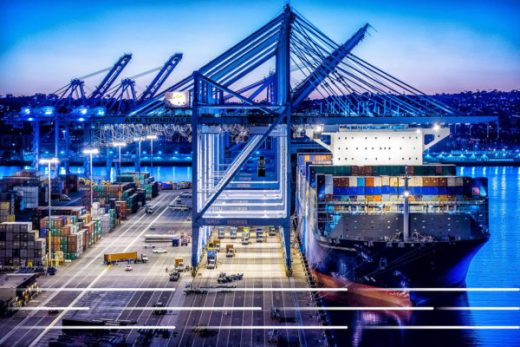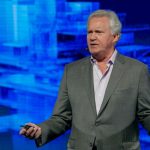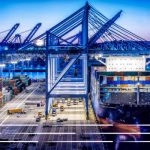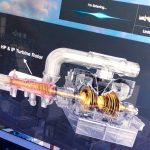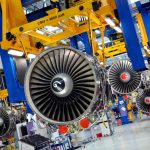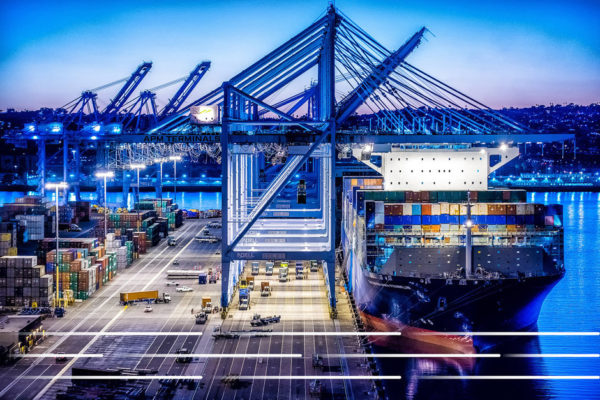GE Transportation and Port of LA come together to track that cargo
GE Transportation and Port of LA come together to track that cargo

IoT is connecting objects across the world. A lot of these objects are items that get shipped and has to arrive predictably. Keeping an eye on where cargo is at anytime is important. (December 04, 2016) GE Transport announced that they are embarking on a pilot concept with the Port of Los Angeles to leverage GE Predix data and technology capabilities to improve an interesting problem statement at the port.
ReadWrite sat down to learn more about this innovative partnership with the CEO of GE Transport, Jamie Miller, and the Executive Director of the Port of Los Angeles, Gene Seroka at the Mind and Machines event in San Francisco.
US Cargo Congestion brings Data Collaboration
Pt 1/3: @JamieSMiller CEO of @GETRANSPORT & Gene Seroka Exec. Dir. of Port of Los Angeles @portofla discussed new partnership at #GEMM16 pic.twitter.com/IlzAatWXPg
— ReadWrite (@RWW) November 17, 2016
Gene Seroka, Port of LA:
Consumer spending fuels our economy. US Companies are looking for predictability and reliability in their supply chain. The industry from liner shipping companies to terminal operators and all the other stakeholders in the chain are going through profound change. Larger vessels, new vessel sharing alliances, financial pressures and the like have brought us to the point where we’ve recently seen a period of congestion in wintertime of 2014 and 15 where all the nodes in the supply chain just about collapsed under their own weight.
But from that came the need for collaboration. Through our abilities as a port, as an integrator and a convener, to bring stakeholders together to talk about real solutions. Out of that came a strong message: Information sharing. We began from there with user discovery sessions, focus groups, trying to draw out what those solutions would mean. Thats how we began our partnership with GE Transportation.
Jamie Miller, GE Transport:
Really building on Gene’s vision, what the solution is about today when an ocean vessel comes into port different providers in the transportation ecosystem whether they are railroads or truckers or even the port itself, typically only find out what’s on that ship — cargo, where its going — about 2 days before it hits port.
Predictability for Ports with GE Predix
Pt 2/3: Gene Seroka Exec Dir of Port of Los Angeles & @JamieSMiller of @GETRANSPORT at #GEMM16 on using @GE_Digital @Predix for @portofla pic.twitter.com/LP6IuMbamR
— ReadWrite (@RWW) November 17, 2016
Jamie Miller, GE Transport:
In partnership with the Port of Los Angeles we’re going to work together to build a scalable platform that will take United States port data along with data from transport providers and create data transparency process.
What this means is we will move from 2 days advance visibility to about 2 weeks advance visibility on an incoming ship. What that means for the whole port and transport ecosystem is that we can really improve logistics management we can reduce dwell time and approval, and we can increase throughput.
In a system which is heavily CAPEX invested increased throughput is a really important outcome for all parties involved. It allows us to get into better equipment planning and appointment scheduling too.
Gene Seroka, Port of LA:
There are other areas that will be impacted as well. The less touches you put on a container the less emissions go airborne. We believe in our plan overall for environment stewardship which dates back now eleven years, that this could be additive to that process and introduce new opportunities to that as well.
If we can streamline the conveyance process and enhance capacity at our port, that also means more jobs. Today, 1 in 12 Angelenos working has a job at the Port. That is the great foundation of Los Angeles Mayor Eric Garcetti and myself to build upon that strength.
We think this is going to be a great way to do that.
Trevor Curwin, ReadWrite:
For the clients who put the containers on the ship in the first place, what are the benefits to them?
Jamie Miller, GE Transport:
One of the big challenges that different modes of transport have whether its railroads or trucking, is pipeline development. Because there are so many intersections in the transportation supply chain, really being very predictive about when a particular shipment is going to get from Point A to arrive at Point B is actually very hard.
Being able to make better predictions brings more productivity and brings the opportunity to have more throughput shared for those modes of transport.
Ports Bring Operators and Data Together
Pt 3/3: How can industry and global ports collaborate? Gene Seroka of @portofLA & @JamieSMiller #CEO of @GETRANSPORT discuss at #GEMM16. pic.twitter.com/NYyid3k4GX
— ReadWrite (@RWW) November 17, 2016
Gene Seroka, Port of LA:
The industry has data points throughout the supply chain universe. They have yet to be harnessed in one area like we are attempting to do right now. That ability to extract value for the stakeholders.
Interesting point is we have over 240,000 unique cargo owners that come through the port every year. Trying to work with those folks to find the best mass production process to intersect with the conveyance idea is really where the value extraction begins.
Trevor Curwin, ReadWrite:
We talk about this at ReadWrite with our readers and among enterprises with this innovation curve with IoT there’s a lot of places for a provider like GE to insert themselves. (Gene) with the data issues you mentioned, what was the data hole that you needed to get to unlock this?
Gene Seroka, Port of LA:
The cargo owners themselves expressed that as the handoffs happen between supply chain service providers there are gaps. We are trying to fill those.
The other piece is that with customs we had an automated supply system back in 2002. I was working in China at the time as they rolled it out. Coming to the Transportation CEO job just a short time ago I thought maybe there is a triangular partnership here between GE, the Port of LA, and customs to share this data in non-proprietary fashion to make sure that we use the strength of that particular position with the know how and depth and breadth of knowledge that GE has.
Jamie Miller, GE Transport:
Ports are really conveners. There are multiple shippers, railroad providers, other operators around the terminal.
If you think about it, each one of those operators runs their own operating infrastructure, they’ve got their own systems, their own data architecture. I think the idea that ports can be convening points and really be integrators, getting parties to work together to open up their data to each other. All this, as Gene said, in a secure way, in a partitioned way, in a way that they only have access to what they need to help bring efficiency to the overall ecosystem.
It’s the next step to unlocking new capacities.
Trevor Curwin, ReadWrite:
Port of LA is the countries largest port. I’ve got to think that other ports around the country if they hear about this they’ve got to be quite interested. Have you hear anything from folks elsewhere in the country?
Gene Seroka, Port of LA:
There has been tremendous positive feedback. I am proud to represent the Port of LA on 4 federal committees. I know from the Secretary of Commerce Penny Pritzker and others that this has been a major focal point. I’m very happy that GE and Los Angeles can take the first step in digitizing the supply chain and I’m hopeful that the door swings wide open from replication of best practices to understanding exactly how each port is unique.
To raise our level of trade competitiveness on the global scale is of great importance to our nation.
Trevor Curwin, ReadWrite:
Thank you both very much for your time.
The post GE Transportation and Port of LA come together to track that cargo appeared first on ReadWrite.
(83)

